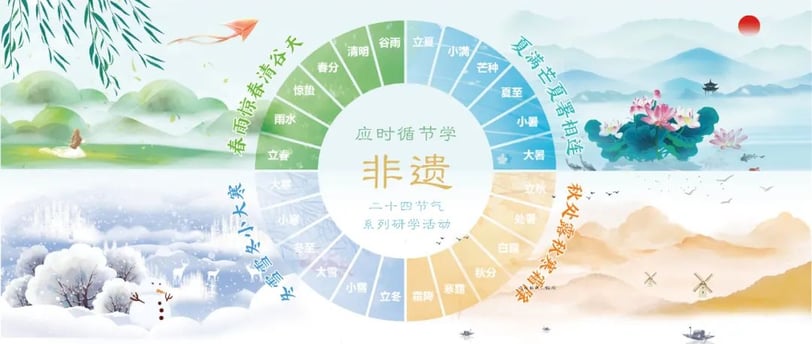Free Delivery on orders over US$200
The 24 Solar Terms
The 24 Solar Terms are an important part of the traditional Chinese calendar, developed to guide agricultural activities. Originating from the Yellow River basin, these terms reflect ancient Chinese people's observations and summaries of astronomical, meteorological, and phenological phenomena.
THE 24 SOLAR TERMS
5/29/20242 min read


The 24 Solar Terms are an important part of the traditional Chinese calendar, developed to guide agricultural activities. Originating from the Yellow River basin, these terms reflect ancient Chinese people's observations and summaries of astronomical, meteorological, and phenological phenomena. The 24 Solar Terms divide the year into 24 segments, each lasting about 15 days, corresponding to different climate changes and agricultural activities. Here is a brief introduction to the 24 Solar Terms:
Spring
1. Lìchūn (Beginning of Spring) - Marks the beginning of spring; the weather starts to warm.
2. Yǔshuǐ (Rain Water) - Increased rainfall and melting ice and snow.
3. Jīngzhé (Waking of Insects) - Rising temperatures awaken insects.
4. Chūnfēn (Spring Equinox) - Day and night are equal in length.
5. Qīngmíng (Clear and Bright) - Clear and bright weather, time for tomb sweeping and spring outings.
6. Gǔyǔ (Grain Rain) - Increased rainfall benefits the growth of crops.
Summer
7. Lìxià (Beginning of Summer) - Marks the beginning of summer; temperatures continue to rise.
8. Xiǎomǎn (Grain Full) - The grains of summer crops begin to fill out.
9. Mángzhòng (Grain in Ear) - Time for harvesting and sowing.
10. Xiàzhì (Summer Solstice) - The longest day and the shortest night of the year, with rising temperatures.
11. Xiǎoshǔ (Minor Heat) - The start of hot weather, but not yet at its peak.
12. Dàshǔ (Major Heat) - The hottest period of the year.
Autumn
13. Lìqiū (Beginning of Autumn) - Marks the beginning of autumn; the weather starts to cool.
14. Chǔshǔ (End of Heat) - The end of the hot summer weather.
15. Báilù (White Dew) - Temperature drops and dew forms on the ground.
16. Qiūfēn (Autumn Equinox) - Day and night are equal in length.
17. Hánlù (Cold Dew) - Further temperature drop, with colder dew forming.
18. Shuāngjiàng (Frost's Descent) - First frosts appear, signaling colder weather.
Winter
19. Lìdōng (Beginning of Winter) - Marks the beginning of winter; temperatures drop significantly.
20. Xiǎoxuě (Minor Snow) - Light snowfall begins.
21. Dàxuě (Major Snow) - Increased snowfall, colder weather.
22. Dōngzhì (Winter Solstice) - The shortest day and longest night of the year, with cold weather.
23. Xiǎohán (Minor Cold) - The start of the coldest period of the year.
24. Dàhán (Major Cold) - The coldest period of the year, approaching the Chinese New Year.
The 24 Solar Terms not only guide agricultural production but are also deeply integrated into Chinese traditional culture, daily life, and festival activities, holding significant importance for the Chinese people's way of life.
